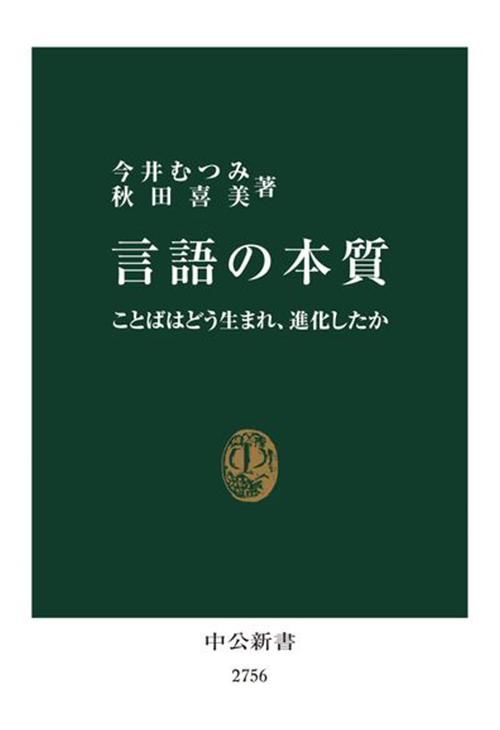Asia Book Awards
Best Asian Books of the Year

Essence of Language
Japan, CHUOKORON-SHINSHA, Mutsumi Imai & Kimi Akita
Author
Mutsumi Imai
Specialized in cognitive science, particularly cognitive psychology, developmental psychology, ad linguistic psychology. Completed all but the dissertation (ABD at Keio University. Received her PhD in cognitive psychology from Northwestern University. Professor in the Faculty of Environmental Information at Keio University. Authored Language and Thought, Learning and Knowledge Acquistion and Solving the Mysteries of Language Development, among others.
Akita Kimi
Specialized in cognitive psychology. Received her PhD from the Graduate School of Cultural Studies at Kobe University. Former lecturer in the Graduate School of Language and Culture at Osaka University. Associate professor in the Graduate School of Humanities at Nagoya University. Authored Cognitive Science of Onomatopée, among others.
Publisher
CHUOKORON-SHINSHA(中央公論新社)
A long-established general publisher founded in 1896. Currently a subsidiary of Yomiuri Group Inc., CHUOKORON-SHINSHA still maintains a long tradition of leadership in the Japanese publishing industry. The company publishes the monthly magazine 『中央公論』, High-level enlightenment books such as 『中公新書』, 『中公選書』 and Highly regarded academic books such as 『The History of Philosophy』. 『中公新書』 is the second longest-running series after 『岩波新書』, and is a well-established series that has produced numerous bestsellers.
This book is an ambitious attempt to explore the origins and evolution of language by focusing on onomatopée (a French word derived from Greek, translated as onomatopoeia and mimetic word), which is one of the most primitive forms of language but has been considered a peripheral topic in linguistics. Authors specialize in developmental psychology, cognitive science, and cognitive linguistics. What makes onomatopée primitive is its similarity to icons. Icons are defined as symbols where signifiant and signifié are similar, specifically referring to pictographs and emoticons in digital media, while examples of onomatopée include “meow meow” (the sound a cate makes, represented as a cat in baby language) and “twinkle twinkle” (depicting a glimmering appearance). Onomatopée is close to icons in that signifiant and signifié are audibly and visually similar. However, there are some Onomatopée expressions that non-native speakers can understand and other that they cannot.
Authors begin by questioning whether Onomatopée qualifies as a language. In light of the ’10 principles of language’ that cognitive science uses to distinguish between human and animal communication, Onomatopée is carefully examined. It is found to align with eight principles, such as ‘communication function’ and ‘meaningfulness’, but to be lacking in ‘arbitrariness’ and ‘duality’. Through this analysis, authors discover that Onomatopée may offer insights into solving the ‘symbol grounding problem’ in cognitive science and generative AI. The ‘symbol grounding problem’ refers to how symbols acquire ‘meaning’ through their connection to the physical world. The problem is, in order words, if symbols do hot have physical ‘grounding’ experience with real world objects somewhere, the objects cannot be truly understood, even if they are represented by another symbols. In considering this problem, the characteristics of Onomatopée that are typical of language – such as being connected to the body, arbitrary but iconic, and both discrete and continuous - make it a promising piece to fill the missing link.
Furthermore, authors examine an experiment involving 11-month-old babies, who were shown round and pointed figures while listening to different word sounds, The brain waves of babies reacted differently when the sounds were "matched" versus "mismatched." In other words, the babies not only understood that ① sounds indicate objects, but also recognized that ② certain sounds resemble the objects themselves. This suggests that the human brain naturally associates sound with objects. Authors posit that the sound of words may represent the first step in "grounding" the body.
This discovery of correspondence between sounds and objects is consistent with the story of Helen Keller, who realized that the spelling of ‘water’ represented the name of an object. This realization sparked a ‘lighting intuition’ in her that every object has a name. This ‘lighting intuition’ reflects the ‘insight of naming’. However, this insight alone does not enable a child to use language effectively. It is because the relationship between signifiant and signifié is not ‘one-to-one’ but ‘one-to-many,’ and the child must learn that meaning is created through patterns in combination of these elements.
Onomatopée plays the crucial role in ‘teaching the child the big picture of language,’ but why isn’t language established solely through Onomatopée? Rather, language does not become language without Onomatopée. Here, the author pays attentions to ‘Nicaraguan Sign Language,’ recognized as the ‘newest language’ in the world. In the course of evolution, Nicaraguan Sign Language became segmented, and the language became more complex and sophisticated. Consequently, the sign language lost some of its iconicity, and at the same time, it differentiated and acquired ambiguity, in other words, it evolved into a true language. Onomatopée also lost some of its iconicity, acquired ambiguity, and ultimately transformed into a language.
However, this does not solve everything. A child who hears the word "meow meow" and learns that it refers to a cat will be able to respond "meow meow" when shown a cat, but this is not the case for chimpanzees. What is natural for humans, that there is a bidirectional relationship between the form of a word and its object, is not natural for animals. This distinction is well documented in experiments conducted with chimpanzees at the world-famous Primate Research Institute at Kyoto University. However, since "the converse is not necessarily true," it is actually the chimpanzees that are "logically" correct, rather than the human children. Human children are unique in that, when they learn the correspondence between objects and symbols, they simultaneously grasp the correspondence between symbols and objects. This assumption, often taken for granted in human language acquisition, is an "overgeneralization" that is not "logically" correct.
It is an ‘abduction’ - translated as symmetry reasoning, retrograde reasoning, and other terms in Japanese, while referred to as hypothetical argumentation, additional reasoning, or abduction inference in Korean - advocated by the American philosopher Charles Sanders Peirce, which hypothetically ‘infers’ causes from results. Then, why do humans create language through such ‘logically incorrect overgeneralization’? Do humans have an innate bias for symmetric inference, or is this something they learn later in life?
Starting from Onomatopée, this book offers a wealth of intellectual stimulation as it gradually approaches the mystery of the origin of language and the development of human language abilities. One of the book’s aims is to evaluate the capabilities of generative AI, particularly large-scale language models like ChatGPT, which are sweeping the world, based on the explanation of this mystery. This may explain why it sold over 400,000 copies within just 10 months of its release. It won the Shinsho Grand Prize in 2023.
